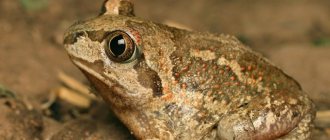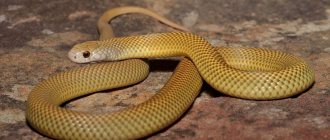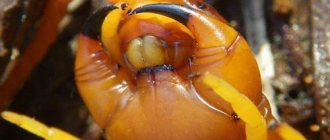The largest amphibian today is the giant salamander, which comes in two types: the Chinese and Japanese giant salamanders. These huge creatures live in eastern China and the islands of Japan. The two species differ slightly from each other and, as a whole, form a species that surprises with its characteristics and features.
What does a giant salamander look like?
Japanese giant salamander
A fairly large amphibian, the length of which most often reaches one and a half meters. The weight of an adult salamander can reach up to 27 kilograms. The tail is long and wide, the paws are thick and short. The front paws have four toes and the hind paws have five. The Japanese giant salamander is completely covered in dark skin that appears wrinkled and has small wart-like growths. Thanks to these growths, the area of the skin increases, which is the salamander’s “nose”, because it breathes through the skin. Of course, there are lungs, but they are not involved in the breathing process, as they are rudimentary. The small eyes of the salamander are not distinguished by vigilance; its vision is extremely poorly developed. The giant salamander also differs from its other relatives in that it has gill openings.
Description of the species
This species of salamander was discovered in the 18th century. In 1820, it was first discovered and described by a German scientist named Siebold during his scientific activities in Japan. The length of the animal's body reaches one and a half meters including the tail. The weight of an adult salamander is about 35 kilograms.
The shape of the animal's body is not distinguished by grace, as, for example, in lizards. It is slightly flattened, distinguished by a large head and a tail compressed in a vertical plane. Small and juvenile salamanders have gills that disappear when they reach sexual maturity.
The salamander has a very slow metabolism. This circumstance allows her to go without food for a long time, and also to survive in conditions of insufficient food supply. Poor vision has led to an increase in other senses. Giant salamanders have acute hearing and a good sense of smell.
Another interesting feature of salamanders is the ability to regenerate tissue. This term refers to the restoration of tissues and even entire organs, if they were lost for any reason. The most striking and familiar example to many is the growth of a new tail in lizards to replace what they easily and voluntarily leave behind when trying to catch them.
Lifestyle of a gigantic salamander
During the day, the salamander prefers to sleep sweetly in some secluded place; all its activity occurs at dusk and at night. It moves along the bottom on its paws, doing it slowly, unlike the small salamanders that are more familiar to us. If it needs to speed up, the giant salamander connects its tail to its paws. Always move against the flow, this helps improve the breathing process. Sometimes smaller individuals can be crushed by their larger counterparts. As a warning, the salamander secretes a pungent-smelling secretion that turns gelatinous when exposed to air.
Giant salamander eggs
Even though the Japanese salamander may not eat for several weeks due to its slow metabolism, it still hunts frequently. The salamander is carnivorous. She does not have saliva - she does not need it, because the process of eating prey occurs under water. The salamander opens its mouth sharply and widely, and literally sucks in the victim along with the water. Prefers fish, small amphibians, crustaceans and some insects.
Lifestyle
This type of salamander lives exclusively in water and is active at night. For a comfortable living, the animal needs a current, so salamanders often settle in fast mountain streams and rivers. The water temperature is also important - the lower the better.
The salamander's diet consists of fish and various crustaceans. In addition, it quite often eats small amphibians and aquatic insects.
The giant salamander lays small eggs, up to 7 millimeters in diameter. A special hole dug at a depth of 1-3 meters is used as a “nest”. In one clutch, as a rule, there are several hundred eggs, which need constant renewal of the surrounding aquatic environment. The male is responsible for creating an artificial current, using his tail to periodically disperse the water in the area of the clutch.
Eggs mature for almost a month and a half. The small salamanders that are born are larvae no more than 30 millimeters long. They breathe through gills and are able to move independently.
Reproduction and offspring of the giant salamander
At the beginning of autumn, giant salamanders gather in nesting areas. These are usually underwater pits or rocky caves. Males are very aggressive and actively fight for space. Females lay their eggs directly in the depressions, after which the male fertilizes them. In these individuals, the male takes care of the offspring. It protects the eggs from predators and its aggressive relatives until all the little salamanders hatch. Like any other amphibian, the salamander goes through three stages of growth: first the egg, then the larva, which then grows into an adult. Throughout their lives, salamanders increase in size. It has not yet been established precisely at what age they reach sexual maturity, but, obviously, this occurs when they reach a large size.
Giant salamander at the Tokyo Zoo Aquarium
Population and species status
The alpine (black) salamander is not currently a species that is threatened by negative environmental influences. The non-profit organization IUCN and the Species Survival Commission have classified the species as Least Concern. Some of the species, like "Salamandra lanzai" as well as "Salamandra infraimmaculata" are categorized as having some risk of extinction or being near vulnerable.
The fire salamander, which lives on the territory of Ukraine, is listed in the Red Book of Ukraine and classified in the second category, which includes vulnerable species. Species native to Europe are protected by the Berne Convention, which protects European wildlife species and their habitats.
Economic value/benefits for humans
In Japan, simply put, the gigantic salamander was... eaten, in China... they are finishing it, and if the persecution of gourmets does not stop, then in the very near future the gigantic salamander - the largest amphibian animal of our time - will have to be bitterly included in the black list of animals that have disappeared forever from the face of the Earth.
In the old days, hunting salamanders was a type of sport hunting, but now this hunting has become illegal and turned into ordinary poaching for the pleasure of tasting a delicious dish.
Interesting Facts
There are several interesting facts about salamanders:
- The meat of these animals is considered a real delicacy, the cost of which is 300-500 euros per kilogram;
- From the body parts of these creatures, medicines are made that prevent diseases of the digestive tract, help with various blood diseases, and treat consumption.
- Both species of these amphibians are listed in the International Red Book. To prevent the complete extinction of these creatures, they are bred on farms and nurseries. To ensure a comfortable existence for them in captivity, deep-sea canals are built.
- Individuals bred in captivity do not reach large sizes.
- In 1936, a book was written about these animals, called “The War on the Salamanders.”
Salamanders managed to outlive dinosaurs and are considered one of the most ancient creatures on Earth. However, now their species is under threat of extinction. Scientists are doing everything possible to preserve these ugly, but completely harmless creatures.
Habitat
If you want to see the maximum diversity of salamanders, then you should go to North America - this part of the world is heavily favored by reptiles.
They also live in Asia and Europe, and some individual species are found in those places where they are most comfortable, regardless of the presence of nearby family members.
For example, in eastern China you can see the largest existing salamander. The giant reptile reaches 80 kg in weight and 180-190 cm in length (including the tail part of the body).
This species is called Chinese-giant, and despite its external danger, its representatives feed modestly: small fish, amphibians and invertebrates that live in the water.
The giant salamander is considered the largest amphibian at the moment, so it stands out not only among its species.
This is what a giant salamander looks like. This reptile prefers to live in forests and hills, but there must be a body of water nearby.
The Chinese-giant variety of these creatures is slowly beginning to die out, which is why the relevant organizations are holding various rallies and putting all their efforts into preserving the species.
So, despite their rather terrifying appearance, reptiles are actively protected.
Interesting! The fire salamander is the most common representative of this family; it lives throughout Europe, but it can also be found in Germany, Poland and Portugal. Individual populations can be found even in Turkey.
Where does he live?
The Japanese species of these animals inhabits the western part of Hondo Island, and is also common in the north of Gifu. In addition, it lives throughout the island. Shikoku and O. Kyushu. The Chinese giant salamander lives in the south of Guangxi province and Shaanxi.
The habitat for these tailed amphibians are mountain rivers and streams with clean and cool water, located at an altitude of about five hundred meters.
Nutrition
Metabolic processes in the body of these tailed amphibians proceed very slowly, so they can go without any food for many days and are capable of prolonged fasting. When they have a need for food, they go out hunting and catch their prey in one sharp movement with their mouths wide open, which creates a pressure difference effect. Thus, the victim is safely directed into the stomach along with the flow of water.
Giant salamanders are considered carnivores. In captivity, there were even cases of cannibalism, that is, eating their own kind.
Reproduction
The mating season lasts from August to September. Males develop a territory for mating, often arranging fights for the best places. A few days later the females arrive. Each partner strives to do everything possible so that the chosen one lays eggs in his nest. The female lays two chains of eggs in the place she likes, each containing 500 eggs, and then swims away. A happy father protects his offspring for 2 months, after which the larvae hatch. The length of each cub is only 30 millimeters. A new father abandons his children to their fate immediately after their birth. When they are 1.5 years old, their lungs will be fully formed and they will be able to go onto land. Until this moment, the cubs are under water. Salamanders reach maturity at 8-10 years.
Lifestyle and behavior
These animals are active exclusively in the dark, and during the day they sleep in some secluded places. At dusk they go out hunting. They usually choose a variety of insects, small amphibians, fish and crustaceans as their food.
They move along the bottom with the help of their short paws, but if there is a need for sharp acceleration, then they also connect the tail. The giant salamander usually moves against the current, as this can allow for better breathing. It emerges from the water onto the shore in very rare cases and mainly after spills caused by heavy rains. The animal spends a lot of its time in various burrows, large recesses formed among underwater rocks, or in tree trunks and snags that have sunk and ended up at the bottom of the river.
The Japanese salamander, as well as the Chinese one, have poor eyesight, but this does not prevent them from adapting remarkably well and orienting themselves in space, since they are endowed by nature with a wonderful sense of smell.
Molting of these amphibians occurs several times a year. The old loose skin completely slides off the entire surface of the body. The small shreds and flakes produced in this process can be partially eaten by the animal. During this period, which lasts several days, they make frequent movements reminiscent of vibration. In this way, amphibians wash off all remaining areas of shed skin.
The giant salamander is considered a territorial amphibian, so it is not uncommon for small males to be destroyed by their larger counterparts. But, in principle, these animals are not overly aggressive and only in case of danger can they secrete a sticky secretion that has a milky color and somewhat resembles the smell of Japanese pepper.
Natural enemies
The salamander has a lot of natural enemies, and in order to save its life, such an unusual animal has adapted to leaving its limbs or tail in the teeth or claws of predators in order to have time to escape. For example, the natural enemies of the Fire Salamander species are snakes, including common and water snakes, predatory fish, large birds and wild boars.
Salamanders are often caught by people, since today many connoisseurs of various indoor exotics prefer keeping such a mythical amphibian at home. For humans, the poison secreted by salamanders is not dangerous and contact of the toxin with the mucous membranes only causes a burning sensation, but under conditions of too much stress such an animal is capable of spraying toxic substances over a relatively long distance.











